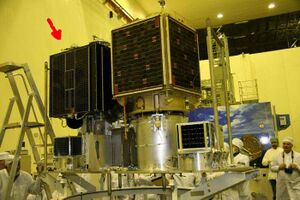Engineering:EgyptSat 1
 EgyptSat 1 (left) and Saudi Sat 3 (right) | |
| Mission type | Remote sensing |
|---|---|
| Operator | NARSS |
| COSPAR ID | 2007-012A[1] |
| SATCAT no. | 31117[1] |
| Website | www |
| Mission duration | Planned: 5 years; Achieved: 3 years, 3 months, 2 days |
| Spacecraft properties | |
| Bus | MS-1TK[2] |
| Manufacturer | Yuzhnoye Design Bureau |
| Launch mass | 165 kilograms (364 lb)[3][4] |
| Power | 65 watts[5] |
| Start of mission | |
| Launch date | April 17, 2007, 07:02 UTC |
| Rocket | Dnepr |
| Launch site | Baikonur 109/95 |
| Contractor | ISC Kosmotras |
| End of mission | |
| Last contact | July 19, 2010[6] |
| Orbital parameters | |
| Reference system | Geocentric |
| Regime | Sun-Synchronous |
| Perigee altitude | 658 kilometres (409 mi)[7] |
| Apogee altitude | 666 kilometres (414 mi)[7] |
| Inclination | 98.1 degrees[7] |
| Main Push broom scanner[4] | |
| Name | EgyptSat 1 |
| Resolution | 7.8 metres (26 ft) (MBEI)[4] 39 metres (128 ft) (cross-track) x 46 metres (151 ft) (along-track) (IREI)[4] |
EgyptSat | |
EgyptSat 1 or MisrSat-1 was Egypt's first Earth remote sensing satellite. This satellite was jointly built by Egypt's National Authority for Remote Sensing and Space Sciences together with the Yuzhnoye Design Bureau in Ukraine and was launched on board a Dnepr rocket on 17 April 2007 from the Baikonur Cosmodrome.
The effort was spearheaded by Dr. Aly Sadek, chairman of the Egyptian Council for Space Science and Technology Research. It in many ways was considered a huge step for the Egyptians since it marked the first time they opted for technology transfer during the manufacturing the satellite rather than simply purchasing one (as in case of the Nilesat satellites). On 23 October 2010, the National Authority for Remote Sensing and Space Sciences announced that control and communication with the satellite had been lost since July 2010.[8][9][10]
History
In 2001, Egypt posted an international tender for the development of the first Egyptian satellite for the observation and remote sensing and bidders from Ukraine, UK, Russia, Korea and Italy competed for the deal.[2][11]
on June 26, 2001 KB Yuzhnoe design bureau from Ukraine announced winner and on October 24, a contract had been signed in Egypt.[12]
A consortium consisted of KB Yuzhnoe design bureau and sub-contractors Ukrainian companies:[2][4][12]
- Yuzhnoye - prime contractor responsible for the platform and the launch
- Yuzhmash - Scientific Research Institute of Radio Engineering Measurements
- Khartron-Konsat and Khartron-Yukom - Research and Scientific Production Enterprises
- KONEX - State Research and Production Enterprise
- CONECS - responsible for the development of the two optical payloads, the onboard payload command and data handling subsystem, as well as for the development of the data processing in the ground segment
- Arsenal - optics manufacturing
Achievements and future plans
- EgyptSat 1 Launched successfully on April 17, 2007.
- EgyptSat 2 with spatial resolution of 5.4 metres (18 ft)[3] was planned to be launched on October 1, 2013 but the launch was put on hold in 2011 following all contact being lost with EgyptSat 1.[13][14] EgyptSat 2 launched into orbit 16 April 2014; last contact with the satellite was April 14, 2015.
- DesertSat with spatial resolution of 2.5 metres (8 ft 2 in)[3] which specialized in identifying and monitoring desert resources[6] is planned to be launched in 2017.[15]
The objective of the three satellites is to provide comprehensive images of Egypt.
Equipment
Egyptsat 1 is considered a miniaturized satellite weighing 100 kg and is carrying two devices:
- An infrared sensing device
- A high resolution multispectral imager together with store and forward communications payload.
See also
- EgyptSat 2
- 2007 in spaceflight
- Egyptian Space Program
References
- ↑ 1.0 1.1 "EgyptSat 1". National Space Science Data Center Administration - National Aeronautics and Space Administration. https://nssdc.gsfc.nasa.gov/nmc/spacecraft/display.action?id=2007-012A.
- ↑ 2.0 2.1 2.2 "EgyptSat-1". http://www.russianspaceweb.com/dnepr_008_egyptsat1.html.
- ↑ 3.0 3.1 3.2 Abd Al-Rahman, Zahraa. "Assessment Of Egyptian Satellite (EGYPT SAT-1) Images For The Production and Updating Of 1:25000 Planimetric Maps". Association of American Geographers. http://www.aag.org/galleries/gisum_files/AlRahman.pdf.
- ↑ 4.0 4.1 4.2 4.3 4.4 Kramer, Herbert J.. "EgyptSat-1". eoPortal Directory. https://directory.eoportal.org/web/eoportal/satellite-missions/e/egyptsat-1.
- ↑ "Archived copy". http://www.arkos.kharkov.ua/sutkm_e.php.
- ↑ 6.0 6.1 http://www.unidir.ch/files/conferences/pdfs/emerging-space-leaders-what-are-the-space-security-concerns-of-rising-space-powers-and-what-do-they-bring-to-multilateral-initiatives-en-1-838.pdf
- ↑ 7.0 7.1 7.2 "EgyptSat 1". National Space Science Data Center Administration (Goddard Space Flight Center). National Aeronautics and Space Administration. https://nssdc.gsfc.nasa.gov/nmc/spacecraft/display.action?id=2007-012A.
- ↑ http://www.almasryalyoum.com/news/%D8%A7%D8%AE%D8%AA%D9%81%D8%A7%D8%A1-%D8%A7%D9%84%D9%82%D9%85%D8%B1-%D8%A7%D9%84%D8%B5%D9%86%D8%A7%D8%B9%D9%8A-%D8%A7%D9%84%D9%85%D8%B5%D8%B1%D9%8A-%C2%AB%D8%A5%D9%8A%D8%AC%D9%8A%D8%A8%D8%AA-%D8%B3%D8%A7%D8%AA-1%C2%BB
- ↑ "Archived copy". http://www.masrawy.com/News/Egypt/Politics/2010/october/25/satalight.aspx?ref=rss.
- ↑ "Archived copy". http://www.masrawy.com/News/Egypt/Politics/2010/october/23/sat.aspx.
- ↑ "Russian application satellites - Ukraine to build satellite for Egypt". http://www.russianspaceweb.com/spacecraft_application.html.
- ↑ 12.0 12.1 "Ukraine’s Space Program". http://mdb.cast.ru/mdb/4-2001/mas/usp/?form=print.
- ↑ "Page redirection". http://www.zarya.info/Calendar.php.
- ↑ "EgyptSat 2 (MisrSat 2)". http://space.skyrocket.de/doc_sdat/egyptsat-2.htm.
- ↑ http://www.freedominion.com.pa/phpBB2/viewtopic.php?p=1011884
External links
- http://space.skyrocket.de/doc_sdat/egyptsat-1.htm
- Egypt to launch first spy satellite
- Egypt to launch its first scientific satellite
- Egypt to launch first scientific satellite in late 2007
- http://www.nilesat.com.eg
